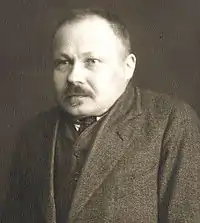
Jonas Heiska (13 October 1873, Jyväskylän maalaiskunta – 3 March 1937, Jyväskylä) was a Finnish Impressionist painter and graphic artist.
Biography
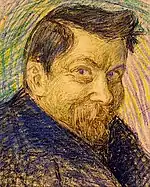
(date unknown)
He was born to a farming family. As a child, he suffered from frequent serious illnesses and developed a curved spine (kyphosis).[1] His long periods of convalescence kept him from agricultural labor and gave him time to display his artistic abilities. In 1890, he was sent to study at the Lyceum in Jyväskylä. While there, he also learned to play the violin and was, for a time, torn between pursuing a career in art or music.[2]
In 1898, he enrolled at the Academy of Fine Arts, Helsinki, where he studied with Eero Järnefelt.[1] He began participating in shows held by the "Helsinki Society of Artists" and was one of a large group of artists chosen to represent Finland at the Exposition Universelle (1900). It was then that he first became interested in impressionism and pointillism.[2] From 1902 to 1904, he was a student at the University of Helsinki, graduating with a degree in drawing.
He briefly returned to his hometown, making sketches and paintings around the family farm, but eventually settled in Jyväskylä, where he set up a studio and gave drawing lessons to the young Alvar Aalto, who was studying at Heiska's old alma mater, the Lyceum.[3] In 1918, he designed the first flag for the Republic of Karelia, but it was replaced in 1920 with one designed by Akseli Gallen-Kallela.[4]
His home was also a gathering place for local musicians. In 1920, he married Maikki Aron (1889–1961), a music teacher.[1] He made an extensive series of illustrations for the classic Finnish novel Seven Brothers by Aleksis Kivi in 1930. They were meant to be published as a book of deluxe prints, but the cost turned out to be too high. His last exhibit was in 1936 at the Strindberg Gallery in Helsinki.
His daughter, Vappu, also became an artist. Before her death in 1993, she gave the family home to the city of Jyväskylä for use as a museum. In 1998, it became part of the "Museum of Central Finland" complex.[1]
Selected paintings
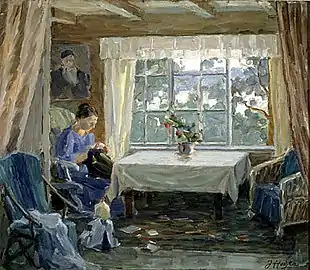 Housework
Housework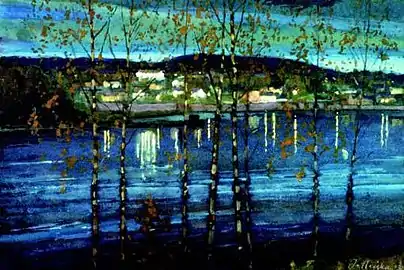 City in the Evening Light
City in the Evening Light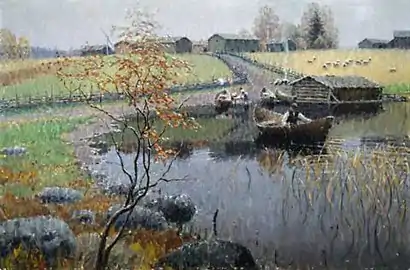 Autumn Afternoon
Autumn Afternoon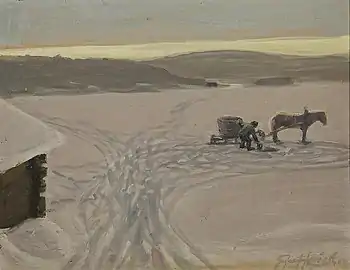 Winter Fishing
Winter Fishing
References
- 1 2 3 4 Brief biography @ Finnica
- 1 2 Brief Biography @ the Avoin Museo.
- ↑ The life of Alvar Aalto @ Lapin: Kulttuuri Kuvina
- ↑ The Flags of Karelia @ Heninen
Further reading
- Louna Lahti, Jonas Heiska, Atena (1995) ISBN 951-96309-8-8
External links
- ArtNet: More works by Heiska
- The Heiska Artist's Home Archived 28 February 2009 at the Wayback Machine @ Avoin Museo
- Heiskan Matkailutila, tourism website.